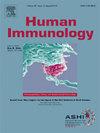RNA editing sites in coding sequences of ABO blood group alleles
IF 2.2
4区 医学
Q3 IMMUNOLOGY
引用次数: 0
Abstract
Purpose
The ABO blood group gene, a protein-coding gene on chromosome 9, is essential for identifying a person’s blood group phenotype. A, B, and O are the three primary alleles of the gene. The ABO blood grouping system is crucial for organ transplantation and blood transfusion because it helps to avoid potentially fatal unfavorable immunological reactions. This study looks into the codon structuring pattern, Codon Usage Bias (CUB) as well as RNA alteration sites in the ABO blood group alleles of Homo sapiens.
Results
The ABO blood group gene has high GC content and low CUB, which both point to significant variation in synonymous codon use. It was discovered that 18 codons were underrepresented and 13 codons were overrepresented in ABO gene. The research indicates that the evolution of ABO blood group genes is shaped by two primary factors: mutational force as well as natural selection, which plays a more substantial role (53.20%) compared to mutational force (46.80%). Transition sites were more than transversion sites. RNA editing sites analysis identified the greatest substitution of C by T nucleotides in ABO alleles.
Conclusion
Overall, the discoveries broaden our understanding of codon utilization mechanisms and the RNA alteration sites in human ABO blood group alleles.
ABO血型等位基因编码序列中的RNA编辑位点。
目的:ABO血型基因是9号染色体上的一种蛋白质编码基因,对确定一个人的血型表型至关重要。A、B和O是该基因的三个主要等位基因。ABO血型系统对器官移植和输血至关重要,因为它有助于避免潜在的致命的不利免疫反应。本研究研究了智人ABO血型等位基因的密码子结构模式、密码子使用偏差(codon Usage Bias, CUB)以及RNA改变位点。结果:ABO血型基因GC含量高,CUB含量低,表明同义密码子使用存在显著差异。结果发现,ABO基因中有18个密码子未被充分表达,13个密码子被过度表达。研究表明,ABO血型基因的进化主要受突变力和自然选择两大因素的影响,其中自然选择的作用(53.20%)大于突变力(46.80%)。过渡位点多于转化位点。RNA编辑位点分析鉴定出ABO等位基因中T核苷酸对C的最大替代。结论:总的来说,这些发现拓宽了我们对人类ABO血型等位基因密码子利用机制和RNA改变位点的理解。
本文章由计算机程序翻译,如有差异,请以英文原文为准。
求助全文
约1分钟内获得全文
求助全文
来源期刊

Human Immunology
医学-免疫学
CiteScore
5.40
自引率
7.40%
发文量
107
审稿时长
12 days
期刊介绍:
The journal''s scope includes understanding the genetic and functional mechanisms that distinguish human individuals in their immune responses to allografts, pregnancy, infections or vaccines as well as the immune responses that lead to autoimmunity, allergy or drug hypersensitivity. It also includes examining the distribution of the genes controlling these responses in populations.
Research areas include:
Studies of the genetics, genomics, polymorphism, evolution, and population distribution of immune-related genes
Studies of the expression, structure and function of the products of immune-related genes
Immunogenetics of susceptibility to infectious and autoimmune disease, and allergy
The role of the immune-related genes in hematopoietic stem cell, solid organ, and vascularized composite allograft transplant
Histocompatibility studies including alloantibodies, epitope definition, and T cell alloreactivity
Studies of immunologic tolerance and pregnancy
T cell, B cell, NK and regulatory cell functions, particularly related to subjects within the journal''s scope
Pharmacogenomics and vaccine development in the context of immune-related genes
Human Immunology considers immune-related genes to include those encoding classical and non-classical HLA, KIR, MIC, minor histocompatibility antigens (mHAg), immunoglobulins, TCR, BCR, proteins involved in antigen processing and presentation, complement, Fc receptors, chemokines and cytokines. Other immune-related genes may be considered.
Human Immunology is also interested in bioinformatics of immune-related genes and organizational topics impacting laboratory processes, organ allocation, clinical strategies, and registries related to autoimmunity and transplantation.
 求助内容:
求助内容: 应助结果提醒方式:
应助结果提醒方式:


